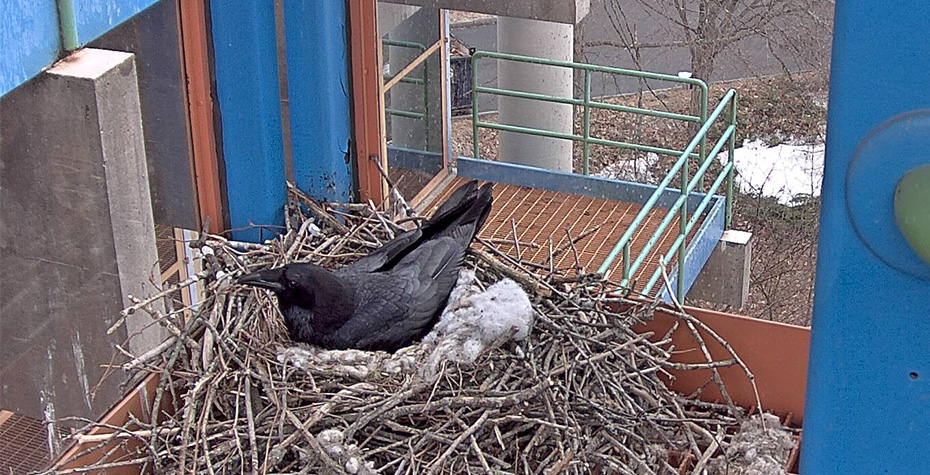Science Faculty and Tech Staff Bring Back Ravencam to Record and Share Bird Behavior

While the College has never had a mascot, our resident ravens—affectionately dubbed Pauline and Henry—may be making themselves our de facto signature animals.
First surprising observers with their appearance in the autumn of 2013, the two black birds took up residence in the cliff-like sides of the Science Center’s sunny south-facing side in the spring of 2014. The common raven is not so common in thickly populated areas, especially in the Northeast. They are territorial and tend to spread their domain over mountainous open spaces.
But last year the pair, whom the community named for the College’s founding couple, found Wellesley’s campus to be a home to their liking. They made a large nest of sticks and grass and settled in to incubate two eggs. From their high nesting place, they could cover a diverse and nutrient-rich landscape of meadows, forests, lake, and streams. Ravens will hunt small animals for prey and, being omnivores, don’t snub carrion on the roadside or dainty morsels from a dumpster. In 2014, one of their eggs hatched and the community and wider world were able to watch via streaming web cam as it grew from a wobbly, wrinkly thing to an insistent eating machine to a bold replica of its parents. The nestling ultimately flew the nest right at Commencement last spring.
Biological sciences and Spanish major Lauren Johnson ’16 and Professor of Biological Sciences Nicholas Rodenhouse published a summary of the birds’ activities at Wellesley in the journal Bird Observer. Vicki Ngan ’18 is assisting in the ongoing analysis of the recordings.
Once the young have fully fledged, the family leaves the nest, but ravens have been spotted through the summer, fall, and winter on campus. It was widely hoped they would return to raise another family, and now they are back!
First appearing to want to make a new nest further down the façade of the Science Center in early March, the ravens were frightened off by people approaching them. After a brief absence, they returned to their nest site of last year. Researchers led by Rodenhouse have been carefully monitoring the birds in order to focus the live streaming camera on the nest again without disturbing them. The video stream will be recorded as it was last year, adding valuable data for research. An unusual aspect of Wellesley’s “birdcam” is that the ravens built their nest near an existing exterior light, allowing us to see them even at night.
They now are incubating three eggs. The typical clutch size for mature common ravens is five eggs, with one frequently being a “dud.” This pair, which we assume to be the same as last year’s, appears to be young given the smaller clutch size and their having ventured out of traditional territory.
The nest location is essentially inaccessible and the ravens don’t care for visitors. But we invite you to visit Wellesley’s window onto their world at any time!
Learn more about ravens and watch the progress of Pauline and Henry’s brood on the Ravencam.
